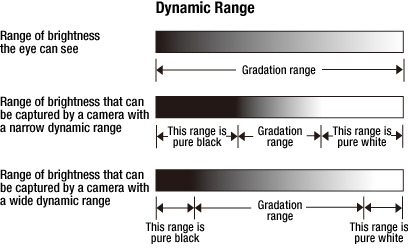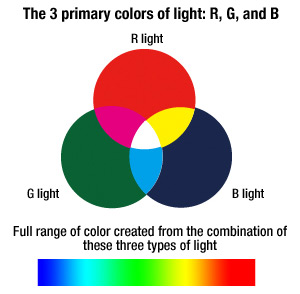Inside Story


- Planning and Design
- Special functions
- Enhanced functions
What is dynamic range?
Some people will already be familiar with the term "dynamic range" from its use in music to refer to the range from the quietest to the loudest sound volume that audio equipment can reproduce. Similarly, for a digital camera the "range of image reproduction from dark to light," is also called "dynamic range." The illustration below shows the dark-to-light range that the human eye is able to perceive along with the ranges that can be reproduced by a "camera with a narrow dynamic range" and a "camera with a wide dynamic range."

It has long been said that "digital cameras have a narrower dynamic range than film cameras" and "compact digital cameras have a particularly narrow dynamic range because they cannot use large image sensors such as those found in SLR digital cameras." The first camera to challenges those limitations and succeed in becoming a "wide-dynamic-range compact camera" is the "CX1."
What narrows a camera's dynamic range?

"We expanded the brightness range
by predicting saturated-pixel
changes." (Manabu Yamada)
A digital camera takes the light captured by the lens and converts it into three types of electrical charges: R (red), G (green), and B (blue). These are changed into electric signals which are reproduced as image data. By combining the three types of light (R, G, and B), the full range of color is represented. If there is a lot of R light, you get red; and if there is a lot of B light, you get blue. If the strengths of the R, G, and B light are all equal, the result is white. "However, the white light's component R, G, and B light does not convert equally into electric signals," said Manabu Yamada, a member of the software development staff.

"The camera registers the RGB light strength unequally, but 'white balance' logic applies coefficients to each so that the RGB values of white areas are the same. Doing this equalization automatically makes it possible to photograph a white thing as white regardless of whether it is outdoors or indoors, or illuminated by fluorescent light or incandescent light. At the point where light perceived as white by the human eye strikes the camera's sensor, the RGB electrical charge ratios are not equal since the G charge is greater than the other two. Because of this, when photographing bright things the G charge quickly becomes full, and above a certain level of brightness you end up with pure white," Yamada explained.
Expanding the range with a pixel output interpolation algorithm
"The technique we used to overcome this problem was a 'pixel output interpolation algorithm,'" Yamada said. "Even if the charge of a given pixel is full, it is possible to predict and interpolate that pixel's charge using the charge strengths of surrounding pixels. This enables the CX1 to reproduce brightness variations even in areas that up to now would have ended up as pure white." The new image processing engine "Smooth Imaging Engine IV" has a customized circuit for the "pixel output interpolation algorithm." The end result is a 1 EV increase in CX1 dynamic range compared to the previous model.
- *EV:This is a measure of the volume of light captured by a digital camera. The higher the number, the greater the volume of light. A 1 EV increase is said to represent about a two-fold increase in the volume of light captured.
"The difficult part was designing the parameters for determining how much to adjust the G light volume in what kinds of situations. We tried shooting with various settings until we could create images that earned a 'That's beautiful!' reaction," Yamada recalled.
- Planning and Design |
- Special functions |
- Enhanced functions


